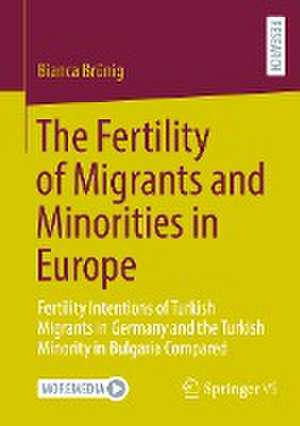The Fertility of Migrants and Minorities in Europe: Fertility Intentions of Turkish Migrants in Germany and the Turkish Minority in Bulgaria Compared
Autor Bianca Brünigen Limba Engleză Paperback – 20 oct 2023
Preț: 523.22 lei
Preț vechi: 615.55 lei
-15% Nou
Puncte Express: 785
Preț estimativ în valută:
100.12€ • 104.75$ • 83.17£
100.12€ • 104.75$ • 83.17£
Carte tipărită la comandă
Livrare economică 03-17 aprilie
Preluare comenzi: 021 569.72.76
Specificații
ISBN-13: 9783658430986
ISBN-10: 3658430982
Pagini: 226
Ilustrații: XVIII, 226 p. 32 illus. Textbook for German language market.
Dimensiuni: 148 x 210 mm
Greutate: 0.3 kg
Ediția:1st ed. 2023
Editura: Springer Fachmedien Wiesbaden
Colecția Springer VS
Locul publicării:Wiesbaden, Germany
ISBN-10: 3658430982
Pagini: 226
Ilustrații: XVIII, 226 p. 32 illus. Textbook for German language market.
Dimensiuni: 148 x 210 mm
Greutate: 0.3 kg
Ediția:1st ed. 2023
Editura: Springer Fachmedien Wiesbaden
Colecția Springer VS
Locul publicării:Wiesbaden, Germany
Cuprins
Introduction.- Migrants, minorities, and assimilation.- Explaining migrant and minority fertility.- Data analytic strategy.- Assimilation status of turkish migrants in germany and turkish minority in bulgaria.- Relationship between assimilation and fertility intentions.- Discussion.
Notă biografică
Bianca Brünig is scientific associate at the Institute of Sociology at Leibniz Universität Hannover. Here, she engages in research on the integration of migrants and minorities in Europe as well as on their fertility behavior.
Textul de pe ultima copertă
This book analyses the relationship between assimilation and fertility intentions for migrants and minorities in Europe. Building upon assimilation theory, it is argued that both migrants and minorities assimilate in the process of intercultural encounters. Given that fertility is part of the cultural dimension of assimilation, it is likely to be influenced by assimilation. Therefore, theories on assimilation and fertility are merged theoretically as well as empirically. Using data from the Generations and Gender Survey, the empirical section builds upon a comparison of Turkish migrants in Germany and the Turkish minority in Bulgaria. Building upon cluster analyses, six clusters within Germany as well as five clusters in Bulgaria are developed to account for heterogeneity of groups. Comparing these clusters in terms of assimilation and fertility intentions it becomes clear that the Turkish minority does not differ in their fertility intentions from the majority. For Germany, Turkish migrants differ from German natives regarding their fertility intentions, but differences are explained by assimilation, especially structural characteristics. When comparing migrant and minority, differences in fertility exist and are accounted for by cultural dissimilarity.
About the author
Bianca Brünig is scientific associate at the Institute of Sociology at Leibniz Universität Hannover. Here, she engages in research on the integration of migrants and minorities in Europe as well as on their fertility behavior.
Bianca Brünig is scientific associate at the Institute of Sociology at Leibniz Universität Hannover. Here, she engages in research on the integration of migrants and minorities in Europe as well as on their fertility behavior.
